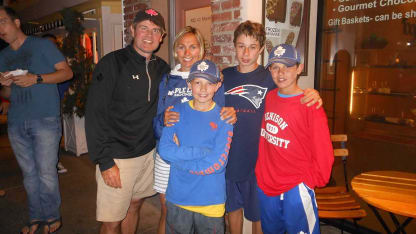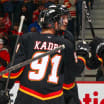Hughes, likely No. 1 pick in 2019 NHL Draft, gets big assist from family
Unique upbringing helps center develop skills that are 'off the charts'
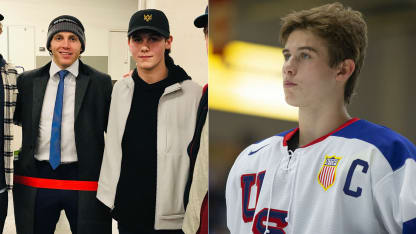
© Courtesy: Hughes family and NTDP
Evaluators look at Hughes, who is widely projected to be the No. 1 pick in the 2019 NHL Draft, and see essentially the same build, skill set and playmaking ability Kane had when the Chicago Blackhawks selected him No. 1 in the 2007 NHL Draft. Since then, Kane has won the Stanley Cup three times, as well as the Hart, Conn Smythe and Art Ross trophies, and become the leading scorer among active NHL players born in the United States with 938 points (356 goals, 582 assists) in 903 games.
And yet the Blackhawks forward believes Hughes can be not just a comparable NHL player, but better.
"I feel like when smaller players come into the League and they have that offensive-type game, it seems to be easy to compare them to a guy like me," said Kane, who is 5-foot-10, 177 pounds, but was 5-9, 160 at the 2007 NHL Scouting Combine. "But I think he does a lot of things better than me, to be honest with you.
"He's always moving, always skating, and even if he's not near the puck or the action, he's still got his speed and he's coming into the zone or coming into the action with a lot of movement and speed."
It's high praise for an 18-year-old who hasn't played a minute of professional hockey, but Hughes (5-10, 170) is no ordinary teenager.
A left-handed center for USA Hockey's National Team Development Program Under-18 Team, Hughes has what seems like the perfect makeup for a surefire prospect: a strong family influence; a relentless nature on the ice; impressive skating ability that Kane considers "off the charts"; and hockey smarts that put him above almost everyone in this year's draft class.
"There's no other Jack Hughes, in my opinion," said David Gregory of NHL Central Scouting. "You can see elements of his game in different players. He has an unbelievable motor, great speed, but a stride not too dissimilar from (Buffalo Sabres center) Jack Eichel in that he generates speed with a lot of motion and a good core.
"His ability to be elusive in traffic is like (Edmonton Oilers center) Connor McDavid, and he's not afraid to challenge that opening that others may not be able to get through because he sees beyond that with the opportunities there."
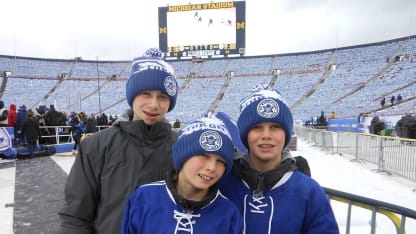
Hughes is No. 1 in NHL Central Scouting's final ranking of North American skaters and expected by many to be selected No. 1 by the New Jersey Devils on June 21 in Vancouver. He likely will become the first NTDP player to go directly from the draft to playing in the NHL.
He led the NTDP with 112 points (34 goals, 78 assists) and a 2.24 points-per-game average in 50 games this season, holds NTDP career records in assists (154) and points (228), and had a 2.07 points-per-game average in 110 games in two seasons.
"Hockey is in my blood. I have so much fun with it ... scoring, competing, working," Hughes said. "I spend so many hours like every other kid who will be drafted. It's something I don't know what I'd do without and such a huge part of my life."
But how did a kid born in Orlando, Florida -- not exactly a hockey hotbed -- become the most highly touted U.S.-born prospect since Auston Matthews was selected No. 1 by the Toronto Maple Leafs in the 2016 NHL Draft? His upbringing is a great place to start.
A prodigy's beginnings
When Jack was born May 14, 2001, his father, Jim, was an assistant for Orlando of the International Hockey League. But the family soon relocated, with Jim taking a job as a Boston Bruins assistant when Jack was 2 months old. When Jack was 2 years old in 2003, the family moved to Manchester, New Hampshire, where youngest brother Luke was born, with Jim an American Hockey League assistant there for two seasons, then coach for one season. They settled in Toronto in 2006 when Jim became an assistant for the AHL team there.
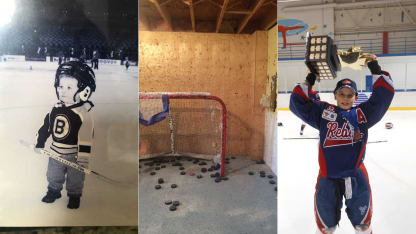
It was in Toronto that Jack, then 5, really started taking to hockey, not only on the outdoor rink at Wedgewood Park, but in the unfinished basement of the Hughes home. Jack and his brother Quinn, who is 19 months older, constantly battled for superiority in their mini-stick hockey games down there.
"They would check each other so hard the house would shake," said their mother, Ellen. "Oh my God, I thought the house was going to fall down, so I would go down there and yell at them, 'Enough. Get off the walls.'
"There were so many holes in the walls. We had one window down there and they were told to put up a pillow to stop anything from hitting it, but I can't tell you how many times we had to replace that window."
Eventually brother Luke, who is 28 months younger than Jack, would join in the games that helped establish a solid hockey foundation, even if it meant damaging the drywall. But though hockey is the lifeblood of the Hughes family, Jim and Ellen wanted the boys to explore all athletic avenues. After all, Ellen played soccer, lacrosse and hockey at the University of New Hampshire. Jim was a defenseman at Providence College.
Jack excelled at baseball as a center fielder between the ages of 9 and 13 but hated practice.
"I begged my mom not to take us," he said, "so that was the only problem."

Still, their parents' emphasis on playing multiple sports helped make the boys well-rounded athletes.
"They ran cross-country against 150 other kids from other schools and came back Nos. 1-2-3," Jim said. "Thing is, you learn about your body and what makes you tick walking into unfamiliar situations by playing other sports. You learn how to adapt, adjust and navigate, so that's why we felt these other sports were great for their overall well-being."
That approach could result in a historic achievement for the Hughes brothers. Never has an American family had three brothers selected in the first round of the NHL Draft.
Quinn was chosen No. 7 by the Vancouver Canucks in the 2018 NHL Draft and made his NHL debut March 28. Luke, a defenseman who will play for the NTDP Under-17 team in the fall, could be a first-round selection in the 2021 NHL Draft. Jack hopes to become the eighth U.S.-born player chosen No. 1, joining forwards Brian Lawton (Minnesota North Stars, 1983), Mike Modano (North Stars, 1988), Kane (Blackhawks, 2007) and Matthews, defensemen Bryan Berard (Ottawa Senators, 1995) and Erik Johnson (St. Louis Blues, 2006), and goalie Rick DiPietro (New York Islanders, 2000).
Quinn, who had three assists in five games with the Canucks, not only is paving the way to the NHL for Jack, he's a big reason he plays as hard as he does.
"I was 4 and he was 6 and I was chasing him around and wanting to do whatever he did," Jack said. "I always wanted to be able to compete with Quinn and play with him but didn't want to slow him down. He kind of pushed me, gave me that work ethic to work with him because he's such a hard worker himself. Catching up with Quinn was always the thing I wanted to do as the younger brother."
'He never skates in a straight line'
The family's stay in Boston was brief but significant. That is where Jack and Quinn first got skating lessons from their parents, Ellen said.
Yes, Jack was on the ice from the time he was 1 1/2 years old.
As for the technique that was stressed, Ellen said, "We were always massive proponents of two hands on the stick, so they're pushing with their lower body following their stick, and their shoulders were in the right direction when they were turning."
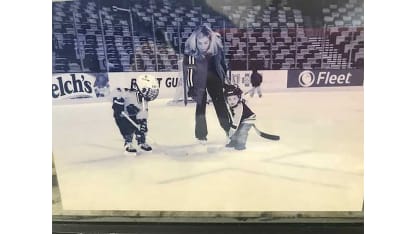
To Jim, it was important that his sons understood the value of generating power on their edges. The key was making sure they knew how to exit a turn faster than entering it.
"Hockey is a change-of-direction sport," he said. "It's not a 200-foot sport. There are so many kids who come out of a turn slower, but in order not to lose speed you need to generate power and it's simply by knowing how to use your outside and inside edges."
Ellen and Jim had the boys wear knee pads, elbow pads and hockey pants so that if they fell while skating, they wouldn't be discouraged from trying the same move again.
"They wore that protection so that everything could be done at full speed," Ellen said. "That's what got them to trust their balance in getting the weight from one leg to the other without worrying about getting hurt."
Jack can see how those drills paid off.
"It's definitely not straight-line speed, it's all edges for us, which makes us as good as skaters as we are," Jack said. "The way we kind of cut and turn, and slice, and change from one direction to the other came second nature to us doing all those drills."
Adam Nicholas, the owner of Stride Envy Hockey in Boston, has worked with Calgary Flames defenseman Noah Hanifin, Ottawa Senators forward Colin White, Minnesota Wild forward Jordan Greenway and NTDP Under-18 forward Matthew Boldy, who is No. 9 on Central Scouting's final ranking of North American skaters. Nicholas has never worked with Hughes but has been impressed watching him.
"He never skates in a straight line," Nicholas said. "If he wants to turn left, he doesn't just skate in a straight line and turn left, he crosses over to the right, so he can create more space so that when he turns, he can build speed in the turn that allows him to get speed differential away from his defender. I'm not going to say he's on the same skating level as Connor McDavid, but they do have similarities in their patterns."
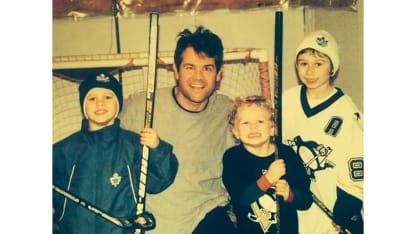
But during games, it's not just about how well Jack skates, but where. John Vanbiesbrouck, USA Hockey assistant executive director of hockey operations and a former NHL goalie, said Jack is one of the most courageous players he's ever seen. When you combine that with his elite hockey sense and speed, it's easy to see why Jack is the likely No. 1 pick.
"The way he can create speed through the neutral zone, enter the zone at top speed and make decisions at that speed ... I don't want to get into player comparisons, but he has a unique ability to weave and see things that few can," Vanbiesbrouck said. "I've seen him take the puck in between big players and get to the front of the net; he's not afraid."
Former NHL forward Jamie Langenbrunner played against Kane in the NHL and with him for the United States. He also coached against Jack at USA Hockey's All-American Prospects Game in September.
"The thing that stands out about Hughes with his skill is the way he competes," Langenbrunner said. "He's on the puck and he wants the puck. It'll be fun to watch him probably for the next 20 years in the NHL."
The decision
The biggest hockey decision in Jack's young career came in 2017.
He most certainly would have been chosen No. 1 by Barrie in the 2017 Ontario Hockey League Draft, joining such notable top picks as McDavid (Erie, 2012), Steven Stamkos (Sarnia, 2006), John Tavares (Oshawa, 2005) and Eric Lindros (Sault Ste. Marie, 1989). But after he had 159 points (58 goals, 101 assists) in 80 games for Toronto of the Greater Toronto Minor Midget Hockey League in 2016-17, Jack chose to take after Quinn and play for the NTDP in Plymouth, Michigan.
"We were close to getting him," said Barrie general manager and head scout Jason Ford. "His family thought long and hard, but they said to us that part of it is the fact they both are Americans and they felt playing for their country and Jack felt playing for his country was important. We put on a good full-court press and tried to get him, but it just didn't work out.
"We respected their decision and didn't select him first overall."

Jack played two seasons with the NTDP, whose typical schedule includes teams from the United States Hockey League (players ages 16 to 20) and teams from NCAA Division I and III, growing as a player and person under coach John Wroblewski. The NTDP also competes in three international tournaments each season.
The OHL is also a proven development path for amateur players with hopes of one day reaching the NHL. The 20-team league, one of the three major junior leagues in the Canadian Hockey League, is for players ages 16 to 21. During the past six years, there have been 89 OHL players selected in the first round of the NHL Draft.
Kane, who had 172 points (84 goals, 88 assists) in 121 NTDP games (1.42 ppg) from 2004-06, played one season with London of the OHL and had 145 points (62 goals, 83 assists) in 58 games in 2006-07 before joining the Blackhawks the next season.
"Elite prospects with the skills and talents like Jack Hughes will develop no matter which development path they choose," NHL Central Scouting director Dan Marr said. "The USA Hockey-NCAA model and the CHL model are both proven development paths with similar yet distinct opportunities. Successful development always revolves around each individual player as some players have high-end natural abilities, some physically mature sooner, and others have excelled throughout high school or minor hockey.
"It's these factors which often steer a player toward one path or the other. The support group of a player (coaches, parents, agents) always try to steer the player toward the path best suited for the individual as they often know best whether a young player can accelerate his development or if the player requires a more measured path, but a player will develop at his own pace no matter which level he plays."
The records for points and assists Jack set in his two seasons with the NTDP are major milestones. He passed Arizona Coyotes forward Clayton Keller (189), Pittsburgh Penguins forward Phil Kessel (180), Kane (172) and Matthews (167) on the points list, and Keller (118), Matthews (88), Kane (88) and Calgary Flames forward Matthew Tkachuk (77) on the assist list.
Jack had 18 points (four goals, 14 assists) and 46 shots on goal in 11 games against college competition, and 48 points (12 goals, 36 assists) and 123 shots on goal in 24 games against USHL competition this season.
Wroblewski said he knew the first time he saw Jack that he was special.
"Quinn was playing with the U-18s and it was in mid-May, so Jack would have just turned 15," Wroblewski said. "He's on the ice with a bunch of kids who are 17, the best in the country, and he's so tiny, so skinny ... the jersey was too big for him. He couldn't skate as well as he does now, but he could still manipulate the defense. I mean, for his level, he could fly, but for out there he was average speed compared to the men two years older than him.
"He couldn't drive the pace, but could still manipulate, like a Patrick Kane can. In those in-tight 2-on-1 situations, you knew the defensemen could close him out if they just went at him with a proper stick, but there was this apprehension from them to close on him, and then he'd rip it by the goalie's ear or slide it through the legs to a guy on the back post. It was truly remarkable to watch, and he had that swagger right away, that smile on his face. Jack Hughes truly loves and has a genuine passion for this game."
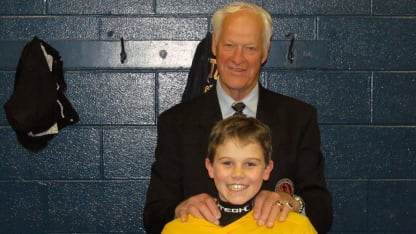
In April, he joined 20 of his NTDP teammates at the 2019 IIHF World Under-18 Championship in Sweden and finished with a tournament-high 20 points (nine goals, 11 assists) for the United States, which won the bronze medal. He set a tournament record with 32 points (14 goals, 18 assists) in 14 games in two seasons (2018, 2019) at the event, passing Washington Capitals forward Alex Ovechkin, who had 31 points (23 goals, eight assists) in 14 games for Russia at the 2002 and 2003 tournaments.
This month, Jack is playing for the United States at the IIHF World Championship in Slovakia, the youngest U.S. player ever at the event. He's playing a top-nine role on a team loaded with NHL talent that includes Kane, who is captain of the team, and Quinn.
"I was excited to have a chance to be able to play more hockey and not have my season come to an end," said Jack, who has one assist and 13 shots on goal through six games while averaging 14:02 of ice time per game in the tournament. "Playing with a group like this is special and something I'll cherish for a very long time. Just to be around these players day after day and learn things from every guy, talk to them and be around pros, I think will help me a lot, actually, with my jump to the NHL next season. This tournament isn't about the draft for me, it's more about becoming a pro and learning the system."
NHL readiness
Wroblewski said that in considering whether Jack is ready for the NHL, one needs to look at how he's evolved in such a short time.
"From two years ago when I first met him through last spring until now, it's is a completely transformed individual," Wroblewski said. "Just look at the way he can generate scoring chances, and how the ice is tilted while he's out there. Jack will find a way to impress on people in the NHL next season with his game. It might not show up every single night, but he's going to find a way.
"The amount of scoring chances he single-handedly generates will continue at the next level, the highest level, which of course is the [NHL]."
Jim, who works in player development for CAA Sports agency's hockey division, believes Jack has the ability to play in the NHL next season, so long as he's put in the right situation and environment.
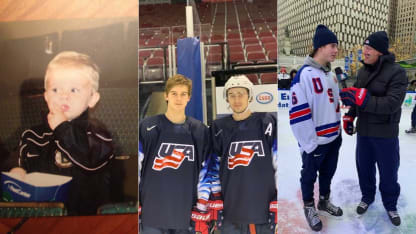
"I've worked with guys who were 6-foot-4 and 6-foot-5 who were invisible and hard to find on the ice, so if you're big and don't use your size to an advantage, there's no sense in having size," he said. "If you look at NHL rosters today, you'd be shocked to see the number of sub-5-foot-11 players in the League. The game is built on speed, skill and courage. The fundamental question for me is, would Jack not be able to be one of those guys?
"You've got to have a blend of size, skill and speed, and those teams possessing that are having a lot of success right now."
Jack is the first NTDP player to be ranked No. 1 on the North American list by Central Scouting since Johnson, now with the Colorado Avalanche, in 2006. Johnson was the second of four NTDP alum chosen No. 1 in the NHL Draft (DiPietro, Kane, Matthews). Jack, who hopes to make it five, has proven himself time and again against older competition.
"I think everyone's goal is to get to the NHL as fast as possible, so for me it'd be a dream come true to play in the NHL next year," he said. "It'd break a barrier, going from the NTDP straight to the NHL. I know it'd be great for me personally and my family, and obviously unreal for USA Hockey too."
The past 12 No. 1 picks have played in the NHL the season after being selected. Johnson played one season at the University of Minnesota before debuting in the NHL in 2007-08.
As for whether he has considered playing overseas if he doesn't make an NHL roster out of training camp, Jack said, "I haven't even thought about it. I kind of just want to play in the NHL next year; that's my plan and that's what I'm focusing on. I'm sure if the team wants to talk to me about (playing somewhere) then we'll have to talk about it, but for me right now it's 100 percent the NHL next season."
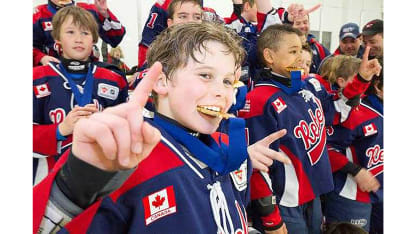
Jack wants not only to play in the NHL next season, but be the first pick. Forward Kaapo Kakko, who plays for TPS in Liiga, Finland's top professional league, and is No. 1 on NHL Central Scouting's final ranking of International skaters, is making a strong case but is predicted by many to go No. 2.
"It'd be a dream come true (to be picked No. 1)," Jack said. "I want to be the first player chosen, be the best player in the draft. I feel like I'm in a good position. I think every kid that's draft eligible and whoever thought about the draft, wants to go as high as he can and wants to be the No. 1 kid chosen."
To Quinn, the important thing is not where Jack is picked, but the fact that his brother's game has evolved so much since the days when they wouldn't think twice about hitting the basement walls with pucks.
"If Jack continues to develop and mature as he's done," he said, "it won't even matter where he's drafted because he will be the best player."
